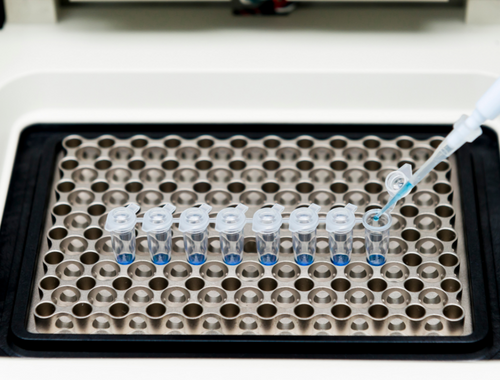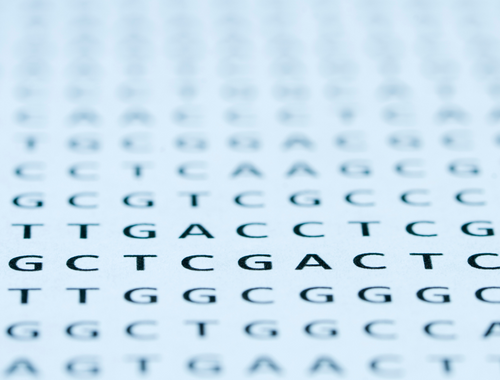Difference Between dNTP and Nucleotide
The most important macro molecule in living cells is perhaps the nucleic acid, especially in the DNA or RNA. It was first observed by scientists in the nucleus of cells, hence the name. It also has some acidic properties, hence nucleic acid. Deoxyribose nucleotide triphosphates (or dNTPs) are the essential building blocks of nucleic acid molecules. dNTPs are kind of reduced nucleotides which serve as the energy source for DNA replication and maintenance of all living systems.

dNTP
Deoxyribose nucleotide triphosphates or deoxyribonucleotide triphosphates, commonly known as dNTPs, are the essential building blocks for new DNA strands in PCR. FYI, PCR, short for polymerase chain reaction, is an in vitro method for the enzymatic synthesis of specific DNA sequences for detailed study. It is simply a technique used to amplify small segments of DNA quickly and accurately. What dNTP does is expand the growing DNA strand using the Taq DNA polymerase. dNTPs are the substrates for DNA synthesis. dNTP is one chain link when it comes to PCR, which then combines with the next link until you have a DNA strand for study. dNTPs serve as the energy source for DNA replication and maintenance of living systems.

Nucleotides
Nucleotides are the basic building blocks of nucleic acids, which in turn have two important functions – one is they hold the genetic information of humans and they perform a wide variety of other functions. It is basically an organic compound that consists of a nucleoside linked to a phosphate group. They are the basic building blocks of DNA and RNA. A nucleotide primarily consists of three parts: a nitrogenous base, a five carbon sugar, and a phosphate group. It is important to note that all three parts of a nucleotide are covalently bonded together. The sugar part may either be ribose or deoxyribose. The sugar in DNA is called deoxyribose and the sugar in RNA is simply called ribose. Fundamentally, nucleotides can be categorized into purines and pyrimidines depending on the structure of the nitrogenous base.
Difference between dNTP and Nucleotide
Definition
– Nucleotides are organic molecules that consist of a nucleoside linked to a phosphate group. They act as monomeric units and form the fundamental structural unit of nucleic acids such as DNA. They store and transmit the genetic information of living systems. One of the common examples of a nucleotide is adenosine triphosphate (ATP). dNTP stands for deoxyribonucleotide triphosphates and they are reduced nucleotides serve as the energy source for DNA replication and maintenance of all living systems. dNTPs are kind of artificial nucleotides used for the synthesis of new DNA strands in the PCR technique.
Structure
– A nucleotide is an organic compound that primarily consists of three molecules: nitrogen containing base, a five carbon sugar, and a phosphate group. A nucleoside, on the other hand, comprises only of two compounds: a nitrogenous base and sugar. dNTPS are artificially preferred nucleotide substrates and are nucleoside triphosphates containing deoxyribose. There are four types of dNTPs which can be divided into two groups: the purines and pyrimidines. The four types of dNTPs are adenine (dATP), cytosine (dCTP), guanine (dGTP), and thymine (dTTP).
Function
– Nucleotides are the basic building blocks of nucleic acids and they play a critical part in the physiology of organisms to catalyze many biochemical reactions by enzymes. Nucleotides basically hold the genetic information of humans and perform a wide variety of other functions, such as metabolism, cell signaling and enzyme reactions. dNTPs are mainly used for a variety of DNA and RNA based applications including PCR, RT-PCR, cDNA synthesis, and so on. They aid in the regulation of replication of both cell and virus genomes.
dNTP vs. Nucleotide: Comparison Chart

Summary
In a nutshell, dNTPs are like reduced nucleotides or artificial nucleotides which serve as the basic building blocks of nucleic acids and play a critical part in the physiology of organisms. dNTPs are mainly used for a variety of DNA and RNA based applications including PCR, RT-PCR, cDNA synthesis, and so on. dNTPs are nucleotides bound to three phosphate groups and include adenine (dATP), cytosine (dCTP), guanine (dGTP), and thymine (dTTP).
Is dNTP a nucleotide or nucleoside?
dNTP is an artificial nucleotide, which is an essential building block of nucleic acid molecules. They are nucleoside triphosphates that contain deoxyribose.
Are dNTPs DNA nucleotides?
dNTPs are the substrates for genome replication by DNA polymerizing enzymes, which are responsible for both replication and maintenance of cellular DNA.
What is the difference between dNTP and NTP?
dNTPs are the essential building blocks of DNA whereas NTPs (Nucleoside Triphosphates) are the essential building blocks of RNA.
What is the difference between the structure of a dNTP and ddNTP?
dNTPs refer to deoxyribonucleotide triphosphates which are building blocks of DNA and ddNTP stands for dideoxynucleotides triphosphate, which is used in chain terminating sequencing.
What is the function of dNTPs?
dNTPs are used for a wide range of DNA and RNA based applications including PCR, RT-PCR, cDNA synthesis, etc.
What is difference between nucleoside and nucleotide?
The main difference between the two is their molecular composition. A nucleotide has three components: a pentose sugar, a nitrogenous base and a phosphate group. A nucleoside, on the other hand, contains only sugar and a nitrogenous base.
- Difference Between Caucus and Primary - June 18, 2024
- Difference Between PPO and POS - May 30, 2024
- Difference Between RFID and NFC - May 28, 2024
Search DifferenceBetween.net :
Leave a Response
References :
[0]Townsend, L.B. Chemistry of Nucleosides and Nucleotides: Volume 1. Berlin, Germany: Springer Science + Business Media, 2013. Print
[1]Illes, P. and H. Zimmermann. Nucleotides and their Receptors in the Nervous System. Amsterdam, Netherlands: Elsevier, 1999. Print
[2]Eritja, Ramon. Nucleic Acids Chemistry: Modifications and Conjugates for Biomedicine and Nanotechnology. Berlin, Germany: Walter de Gruyter GmbH, 2021. Print
